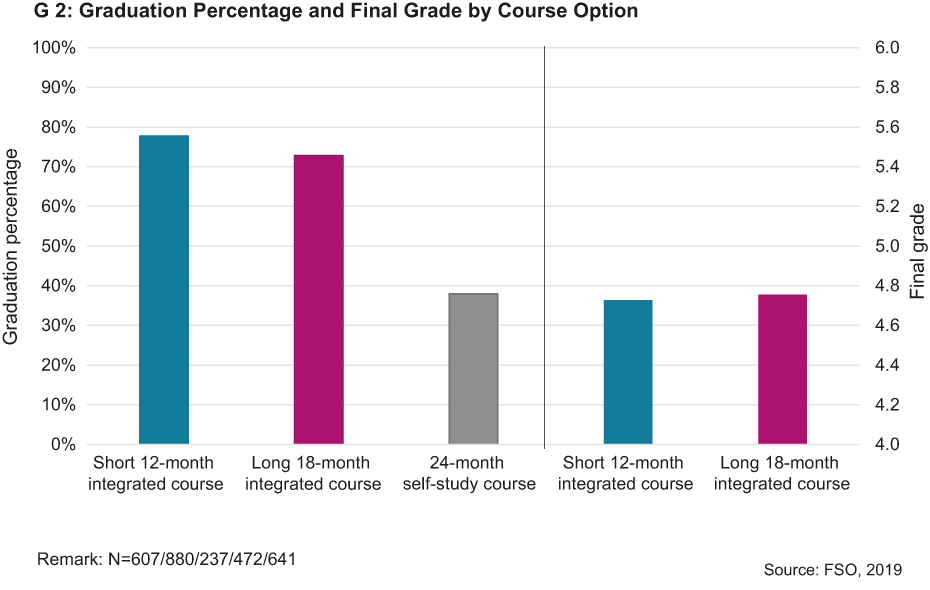Vocational Baccalaureate II: More Self-Study Results in Higher Number of Dropouts but Same Grades
- KOF Bulletin
- Education
KOF researchers have investigated the impact of self-study on the probability of completing a vocational baccalaureate II course. They found that a higher degree of self-study results in a higher number of dropouts. By contrast, the final grades are no different.

Between 2000 and 2018, the number of students acquiring the vocational baccalaureate certificate more than doubled from 6,500 to approximately 14,000 (Federal Statistical Office, FSO, 2018). A distinction is made between vocational baccalaureates I and II. While the first is acquired in parallel to the EFZ (Federal Certificate of Competence), vocational baccalaureate II courses are taken after acquiring the EFZ. Vocational baccalaureate II certificates are gaining importance (BFS, 2019).
The institution which commissioned this study offers three options for acquiring the vocational baccalaureate II certificate. The first option is a two-year self-study course which requires students to study independently at home. The second option – the long 18-month integrated course – combines self-study with one day of class-based lessons a week. The degree of self-study in this course is around 70%. The third option – the short 12-month integrated course – is the shortest of the three. Students spend two days a week in classes and just under 50% in self-study.
Differences arise in the first semester
The courses thus vary substantially in terms of their degree of self-study. This begs the question whether a high percentage of self-study is conducive and prepares students for the successful acquisition of the vocational baccalaureate. The KOF researchers have investigated this question with the help of administrative data provided by the educational institution under review. The data relate to all students who started studying for vocational baccalaureate II certificates at this school between 2007 und 2018. However, the data relating to students on the self-study course only reach back to 2012.
The left side of Graph x shows that 78% of the students on the short integrated course acquired the vocational baccalaureate. At 73%, the percentage of successful graduates of the long integrated course is slightly lower. According to statistical analysis, this difference arises in the first semester, with no further differences in graduation probability arising thereafter. In the case of the self-study course, the number of students acquiring the vocational baccalaureate is significantly lower. No more than 38% of the students successfully complete this course.
The right side of Graph x shows the correlation between the degree of self-study and the final grade. At 4.7 for the short integrated course and 4.8 for the long course, the average final grades are almost identical. Respective data for the self-study course were not available. The results do not change if differences in observed characteristics, such as gender, initial grades or distance between home and school, are considered.
Comparison of the results of the integrated courses with the average results of courses with low degrees of self-study in the Canton of Zurich presents a similar picture (FSO, 2018). While the graduation probability for the integrated courses at the institution under review is lower than for the Zurich-based courses, the final grades are very similar. However, it must be noted that the differences in the students’ characteristics cannot be considered.
High degree of self-study requires more discipline
The results suggest that a higher degree of self-study leads to more dropouts. However, since the final grades are not affected, the degree of self-study does not appear to have an impact on the course quality. This could be interpreted such that a high degree of self-study requires more discipline since students feel less integrated into a class structure. As a consequence, more students drop out.
Literature
BFS, 2019. Berufsmaturitäten: Basistabellen. [Online] Available at: external page https://www.bfs.admin.ch/bfs/de/home/statistiken/bildung-wissenschaft/bildungsabschluesse/sekundarstufe-II/allgemeinbildende-ausbildungen.assetdetail.8186158.html
BFS, 2019. Berufsmaturitätszeugnisse nach Ausbildungsart, Geschlecht, Richtung, Schulkanton und Wohnkanton, s.l.: Available at: external page https://www.bfs.admin.ch/bfs/de/home/statistiken/bildung-wissenschaft/bildungsabschluesse/sekundarstufe-II/allgemeinbildende-ausbildungen.assetdetail.5066877.html
Contact
No database information available
